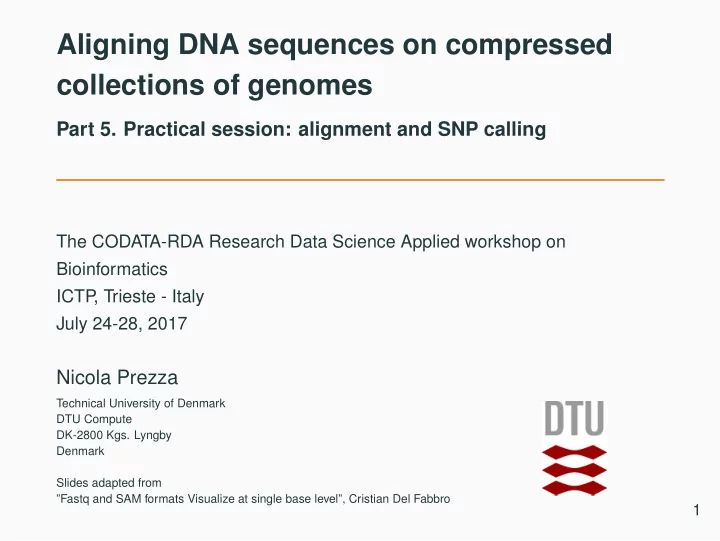

Aligning DNA sequences on compressed collections of genomes Part 5. Practical session: alignment and SNP calling The CODATA-RDA Research Data Science Applied workshop on Bioinformatics ICTP , Trieste - Italy July 24-28, 2017 Nicola Prezza Technical University of Denmark DTU Compute DK-2800 Kgs. Lyngby Denmark Slides adapted from ”Fastq and SAM formats Visualize at single base level”, Cristian Del Fabbro 1
Outline Fastq SAM format View alignment at single base level SNP calling 2
Fastq
Raw data The RAW data we get as input is a list of DNA reads Each read comes with its name and quality (i.e. how sure we are that each base called by the sequencer is correct) fastq format: 4 lines for each read (see next slide) 3
Raw Data 4
Raw Data 5
Phred values 1 error probability = Q 10 10 Example In the previous slide, a base associated with quality ’J’ has Phred quality score ASCII(J)-33 = 74 - 33 = 41. The probability that this base is incorrect is 1 / ( 10 41 / 10 ) ≈ 0 . 00008 6
Exercise Create a valid fastq file /scratch/2M low quality.fastq containing all sequences from /scratch/2M.fastq that have a sub-sequence of at least 20 bases with Phred score 0. How many sequences do you obtain? Hint Convert Phred 0 to ASCII, use grep to search, filter the result to remove extra symbols added by grep . 7
SAM format
The SAM and BAM formats A DNA aligner takes as input an indexed genome and a fastq file and produces a SAM or BAM file A SAM file contains, for every aligned read, the information relative to the alignment. SAM is a text format: you can visualize and read it. 8
The SAM and BAM formats BAM is the binary version of SAM. In a BAM file, information is ”packed” and cannot be directly visualized. As a result, BAM files are much smaller than SAM. Using samtools we can (among other things), convert SAM ↔ BAM 9
Inside the SAM/BAM file 10
Columns 11
Flags 12
Flags http://broadinstitute.github.io/picard/explain-flags.html 13
Other info After the quality string, there are other info. In particular, the field NM:i tells us the number of mismatches of the alignment 14
bwa mem BWA BWA (Burrows-Wheeler aligner) is one of the most accurate and fast DNA aligners. We will use the algorithm BWA-MEM (the newest and more optimized for reads of length ≥ 70) Index construction bwa index genome.fa Alignment single reads: bwa mem genome.fa reads.fastq > out.sam paired-end reads: bwa mem genome.fa reads 1.fastq reads 2.fastq > out.sam 15
bwa mem Exercise Align the paired-end reads 2M 1.fastq and 2M 2.fastq on the genome hg38 reduced.fa , and save the alignment in a file alignment.sam in folder alignment Exercise Count the number of alignments with 1, 2, ..., 9 mismatches 16
View alignment at single base level
The result of an alignment can be visualized using graphical tools such as tablet Before using tablet, we must convert the SAM file to BAM and the BAM file must be sorted and indexed. Indexing is needed to speed-up the retrieval of alignments overlapping a specific genome position 17
SAM to BAM conversion To convert SAM to BAM, we use samtools : samtools view -b -S alignment.sam > alignment.bam Flag -S means that input is SAM. Flag -b means that output must be BAM. 18
Samtools and Tablet Sorting and indexing bam files samtools sort input.bam out sorted (creates file out sorted.bam) samtools index out sorted.bam Visualize • Just type “ tablet ” in the terminal and a interactive program starts. • Open assembly → select the sorted bam and fasta files • Selecting color schemes → variants we can visualize errors and SNPs 19
SNP calling
SNP calling We can call SNPs using samtools/bcftools: samtools mpileup -uD -f genome.fasta alignment sorted.bam | bcftools view -vc - > calls.vcf samtools part • -u tells it to output into an uncompressed bcf file (rather than compressed) • -D tells it to keep read depth for each sample • -f tells it that the next argument is going to be the reference genome file bcftools part • -v tells to output vcf file (ASCII, readable) rather than bcf (binary) • -c tells to do SNP calling • the last ”-” means that input comes from stdin (i.e. the pipe) 20
VCF format 21
SNP calling Exercise Call the SNPs resulting from the alignment of 2M 1.fastq and 2M 2.fastq on the genome hg38 reduced.fa , and save the output in a file calls.vcf in folder calls Exercise Use tablet to manually verify and visualize some SNP positions predicted in the previous exercise (use function ”jump to base”) 22
Recommend
More recommend